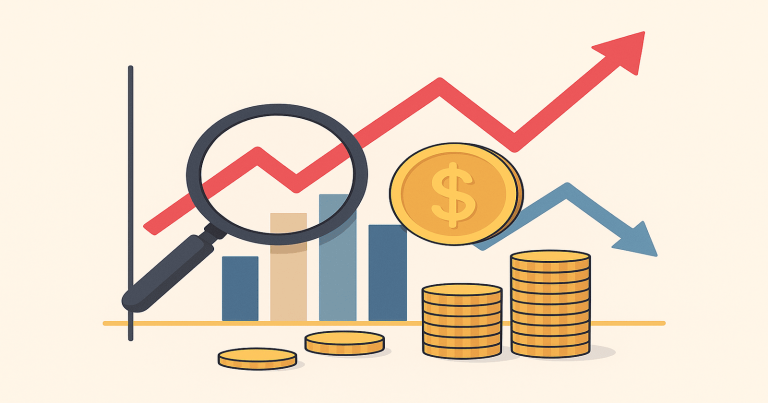Prices don’t stay the same—they rise, fall, and shape how we live, spend, and save. But how do we actually measure that change? That’s where the consumer price index formula becomes important. Behind every news headline about inflation lies a simple mathematical method that tells us how fast costs are moving. If you’re planning a budget, understanding this formula gives you a clear view of price trends and purchasing power.The consumer price index formula is a way to measure the change in prices of goods and services that people use every day. These goods include food, clothes, school supplies, medicines, and more. Economists use the consumer price index (CPI) to track inflation. The consumer price index formula is simple. It compares the cost of a basket of goods in the current year with the cost in a base year. It shows the percentage change in prices.
What is Consumer Price Index (CPI)?
The Consumer Price Index, or CPI, is a number that shows the average change in the prices of a set of goods and services over time. These goods and services are the ones that people use every day—like food, housing, clothing, transport, medicine, and school items.
When the CPI number goes up, it means prices are going up. This is called inflation. When the CPI number goes down, it means prices are falling. This is called deflation. The CPI is an important tool that helps us know how the cost of living is changing.
In India, the Ministry of Statistics and Programme Implementation (MoSPI) is the government body that calculates and publishes CPI data every month. They collect price data from many cities and villages across the country. They then use this data to calculate the index.CPI helps the government make decisions about money, salaries, pensions, and even taxes. Banks also use CPI to decide on interest rates.
Consumer Price Index Formula
The consumer price index formula is used to compare how prices have changed between a base year and the current year. It helps you see the percentage rise in prices.
The formula is:
| CPI = (Cost of Basket in Current Year / Cost of Basket in Base Year) × 100 |
Let’s break it down:
- Cost of Basket in Current Year: Total price of fixed goods at today’s prices
- Cost of Basket in Base Year: Price of the same goods in the past (base year)
- 100: We multiply by 100 to show percentage
Example of CPI Calculation
Imagine a basket of goods cost ₹1,000 in 2012 (base year). In 2025, the same items cost ₹1,300.
Use the formula:
CPI = (1300 / 1000) × 100 = 130
That means inflation is 130% since 2012.
What is Included in the CPI Basket?
The CPI basket is a list of goods and services that people use in daily life. These items are used to calculate the Consumer Price Index (CPI). The government collects the prices of these items every month and compares them to past prices. This helps to know whether the prices are rising (inflation) or falling (deflation).
The items in the CPI basket are chosen based on surveys from families across India. These items are grouped into different categories. Each group is given a weight, which shows how important it is in a family’s monthly budget. If people spend more money on food, then food will have a higher weight. If fuel prices rise, it also affects the index depending on its weight.
1. Food and Beverages
Food and drinks are the most important part of the CPI basket. They have the highest weight—almost 45% in rural areas and around 30% in urban areas. Since everyone buys food daily, any change in food prices affects the CPI quickly. That’s why food inflation has a big role in India’s overall inflation rate.
2. Clothing and Footwear
This group includes all the clothes and shoes that people wear. It makes up around 6% of the total CPI basket. These items are not bought every day, but they are necessary. Price changes in textiles or leather goods can affect the index.
3. Housing
The housing category includes the rent that people pay for living in houses. It is only included in urban CPI, and it has a high weight of about 10%.In cities, housing is expensive. So, a rise in rent or house repair costs can increase urban CPI quickly.
4. Fuel and Light
This category covers the cost of things that provide energy to our homes. It has a weight of about 7%. When fuel prices rise, electricity and gas bills also rise. This makes the cost of living go up, so CPI rises.
5. Health
Health has become a big concern, especially after COVID-19. This part of the basket covers the cost of: Medicines, Doctor’s fees, Hospital charges, Diagnostic tests like X-rays and blood tests
Health inflation can affect families deeply. Even small increases in medicine prices can change the CPI.
6. Education
Education is another important category in the CPI basket. It includes: School and college fees, Books and stationery (notebooks, pens, pencils), Tuition fees, Coaching classes. Families spend more on education every year. When these prices rise, the CPI goes up.
7. Transport and Communication
This category includes the cost of travelling and staying connected.Petrol and diesel prices affect both transport and goods movement. So, when fuel prices rise, CPI goes up for almost every category.
8. Personal Care and Effects
These are small items used in everyday personal care. These include:Soap, shampoo, toothpaste, Hair oil, cosmetics, Shaving items, Detergents and cleaning supplies
These items may seem small, but they are used daily in every home. When their prices rise, it slowly increases the CPI.
Types of Consumer Price Index (CPI) in India
The government calculates different types of Consumer Price Index (CPI) in India to understand how prices affect different groups of people. Each group has different lifestyles and spending habits. For example, a person working in a city spends money differently than a farmer in a village. So, we need different CPI types to track inflation properly.
There are four main types of CPI in India. Each one is designed for a specific group. Let us understand them one by one.
1. CPI-IW (Consumer Price Index for Industrial Workers)
CPI-IW is made for people who work in factories and industries. These include textile workers, mill workers, and people working in organized sectors. These workers usually live in cities or towns and earn regular monthly wages.
The government uses CPI-IW to decide Dearness Allowance (DA) for central government and public sector employees. DA is a part of salary that helps workers fight inflation. If CPI-IW goes up, then DA also goes up. This helps workers keep up with the rising cost of living.
This index is also useful in wage agreements and is often used in court decisions related to salary changes.
2. CPI-AL (Consumer Price Index for Agricultural Labourers)
CPI-AL is made for people who work on farms. These are agricultural labourers who work on someone else’s land and are paid daily or weekly wages. They mostly live in rural areas and spend more money on food and basic needs.
This index helps the government understand how price changes are affecting farm workers. It is used to fix minimum wages for rural labour, create farm support schemes, and check poverty levels.
When food prices go up, CPI-AL increases fast because farm workers spend a large part of their income on food. This makes CPI-AL very important for rural policies.
3. CPI-RL (Consumer Price Index for Rural Labourers)
CPI-RL is similar to CPI-AL but it covers all types of rural labourers, not just those working in farms. It includes people like construction workers, carpenters, drivers, tailors, and people doing small jobs in rural areas.
This index gives a bigger picture of how price changes are affecting all kinds of rural jobs. It helps the government plan social welfare schemes like MGNREGA and decide how much help rural workers need during inflation.
CPI-RL is very useful for states and ministries that want to focus on the rural economy and workers who are not involved in farming.
4. CPI Combined (Rural + Urban)
CPI Combined is the most commonly used CPI type in India. It combines price data from both urban and rural areas. This index gives a full national picture of inflation.
The Reserve Bank of India (RBI) uses CPI Combined to set interest rates and control inflation. It is also used by the government to make important decisions on taxes, pensions, and subsidies.
CPI Combined is published every month and includes all goods and services like food, clothing, education, fuel, health, and rent. Since it includes all groups of people, this index is the most useful for policy making.
Importance of Consumer Price Index (CPI)
The Consumer Price Index (CPI) is very important for everyone—students, families, workers, businesses, and the government. It is not just a number. It tells us how the prices of common goods and services change over time. These goods include food, clothes, medicine, transport, rent, school fees, and more.
1. Helps People Understand Inflation
CPI helps people know if prices are going up or down. When the CPI increases, it means prices have gone up. This is called inflation. When the CPI falls, it means prices have gone down. This is called deflation. Knowing this helps people plan their monthly expenses. For example, if food prices rise, families may reduce spending on non-essential items.
2. Helps Families Make Budgets
Families use CPI to plan their budget. If CPI shows prices have increased by 10%, then people know they need to spend more money for the same goods. This helps them save wisely and avoid unnecessary expenses. CPI also helps them understand where most of their money is going—on food, rent, or fuel.
3. Used by Government for Salary and Pension
The government uses CPI to fix salaries and pensions for its employees. When inflation rises, the cost of living increases. So, the government increases Dearness Allowance (DA) based on CPI to match the higher prices. This helps workers and retired people maintain their standard of living.
4. Helps in Welfare Schemes
CPI helps the government in deciding how much financial help to give under welfare schemes. For example, free food grains, health schemes, or school support programs are linked to CPI. If prices rise, the government increases its support to poor and middle-income families.
5. Used by RBI to Control Inflation
The Reserve Bank of India (RBI) looks at CPI to check how fast inflation is rising. If CPI goes up too quickly, the RBI raises interest rates to slow down inflation. If CPI is low, the RBI may lower rates to help people borrow and spend more. This keeps the economy balanced.
6. Helps Businesses and Companies
CPI helps businesses decide how to set their product prices. If input costs rise (like raw materials), companies may increase the price of their goods. Companies also use CPI to plan salaries for employees. Long-term contracts and deals often use CPI to decide price changes over time.
Limitations of Consumer Price Index (CPI)
The Consumer Price Index (CPI) is very useful, but it also has some limitations. It does not always give a perfect picture of how prices affect every person. CPI is based on average prices, and it uses fixed items in a basket. So, it may miss some new trends, quality changes, or local price changes.
Let’s understand each limitation in detail:
1. CPI Does Not Include Spending by Rich People
CPI is based on the spending habits of middle- and lower-income groups. It does not include luxury items like expensive watches, designer clothes, or high-end cars. Rich people spend more on luxury goods, but CPI does not count these items in its basket. So, it may not show the full effect of inflation on the wealthy.
2. CPI May Miss New Goods and Services
CPI uses a fixed basket of goods and services. This basket is updated only once in many years. But today, new items enter the market quickly—like mobile apps, online subscriptions, smart gadgets, and new types of food. If CPI does not update its basket regularly, it may miss these new items that people now use every day.
3. CPI Does Not Measure Changes in Product Quality
Sometimes, a product becomes better, even if its price stays the same. For example, a ₹500 mobile phone charger in 2025 may charge faster or last longer than one in 2015. But CPI only looks at the price, not at the quality. So, it may say there is no inflation, even when the product has improved. This can give a wrong picture of value.
4. CPI Does Not Show Regional or Local Price Changes
CPI shows average price changes for a large area, like a whole country or state. But prices can vary from one city to another or even from one market to another. For example, vegetable prices in a flood-hit area may go up suddenly, but CPI may not show this spike because it is based on average data from many places.
5. Fixed Weights May Not Match Real-Life Spending
Each item in the CPI basket has a fixed weight, which tells how important that item is. For example, food may have 45% weight. But people’s spending habits change. A family may start spending more on education or health in one year and less on food. But CPI keeps using the same weights for many years, so it may not reflect true household expenses.
6. CPI May Not Cover All Social Groups
CPI is calculated based on selected samples from rural and urban areas. But it may not include data from small tribal villages, high-income gated societies, or remote hill areas. So, the index may not cover every group equally, and it might leave out unique problems faced by those areas.
Consumer Price Index Formula FAQs
1. What is the formula for CPI?
Ans: The formula is CPI = (Cost of Basket in Current Year / Cost in Base Year) × 100
2. What is the base year for CPI in India?
Ans: The current base year is 2012.
3. Who calculates CPI in India?
Ans: The Ministry of Statistics and Programme Implementation (MoSPI) calculates CPI.
4. What does a CPI of 120 mean?
Ans: It means prices have increased by 20% from the base year.
5. What does CPI measure?
Ans: It measures inflation—the rise in prices of goods and services over time.
6. Why is CPI important for RBI?
Ans: RBI uses it to control inflation and set interest rates.


